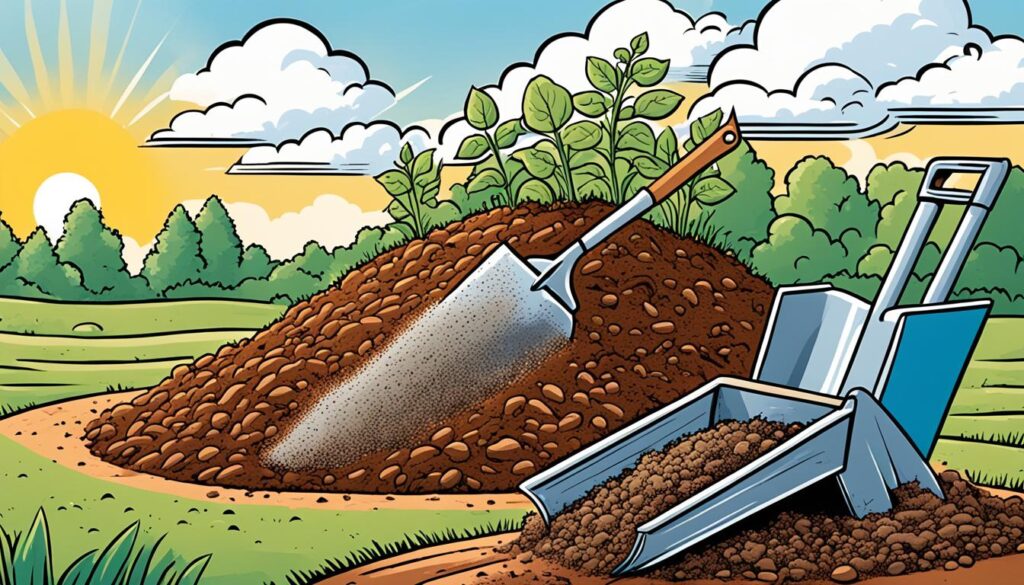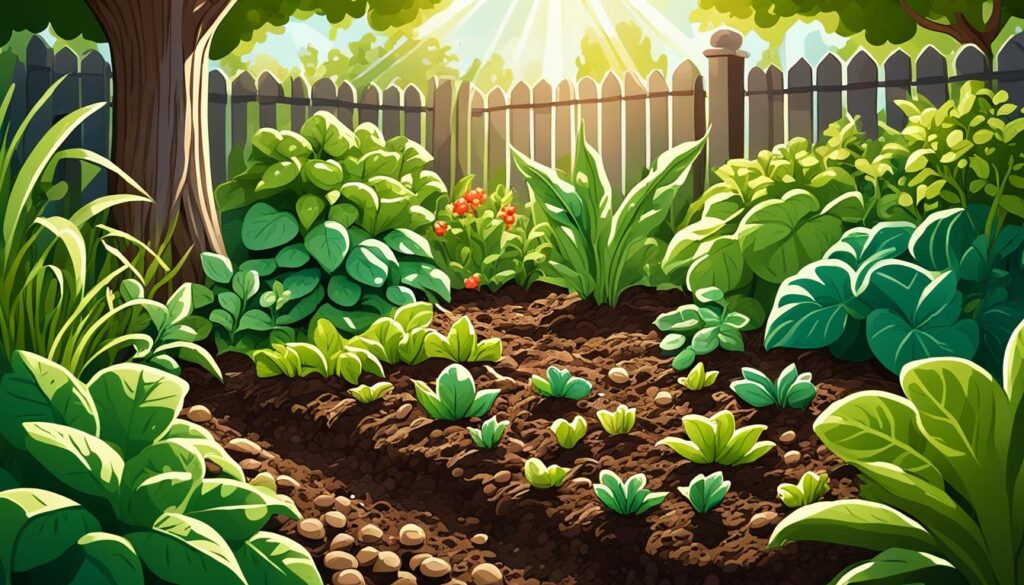If you’re struggling with heavy, sticky clay soil in your garden, don’t worry – there are solutions! Clay soil can be challenging to work with, but with the right soil amendments, you can transform it into nutrient-rich, fertile soil that will support thriving plants. Adding organic matter such as compost, leaf mold, and well-rotted manure is the key to improving clay soil. Organic matter lightens the soil texture, improves drainage and aeration, adds essential nutrients, and encourages the growth of beneficial soil microorganisms. Say goodbye to stubborn clay and hello to healthy, vibrant plants!
Key Takeaways:
- Clay soil can be transformed into fertile soil with the right amendments.
- Add organic matter like compost, leaf mold, and well-rotted manure to improve clay soil.
- Organic matter lightens the soil texture, improves drainage and aeration, and adds essential nutrients.
- Beneficial soil microorganisms thrive in soil amended with organic matter.
- Transforming clay soil leads to the growth of healthy, vibrant plants.
Benefits of Organic Matter for Clay Soil
Organic matter is the ultimate soil amendment for clay soil. It offers a range of benefits that will help you transform your clay soil into a thriving environment for your plants.
Improving Soil Texture
One of the primary advantages of organic matter is its ability to improve soil texture. Clay soil is heavy and compacted, making it difficult for plant roots to penetrate and for water to drain effectively. By adding organic matter, such as compost or well-rotted manure, the heavy texture of the clay soil is lightened. This allows plant roots to explore and grow more easily, resulting in healthier and more productive plants.
Enhancing Drainage
Poor drainage is a common issue with clay soil, leading to waterlogged conditions that can drown plant roots. Organic matter helps improve drainage by creating pore spaces in the soil structure. These pore spaces allow excess water to drain away from the root zone, preventing waterlogging and reducing the risk of root rot. The improved drainage also helps to oxygenate the soil, providing essential oxygen to the roots for optimal growth.
Adding Essential Nutrients
Clay soil often lacks essential nutrients needed for plant growth. Organic matter is a valuable source of nutrients for plants. As it decomposes, organic matter releases nutrients into the soil, making them available for plant uptake. This helps in promoting healthy growth and development of your plants, resulting in better yields and stronger resistance to diseases and pests.
Supporting Beneficial Soil Microorganisms
Organic matter acts as a food source for beneficial soil microorganisms, such as bacteria and fungi. These microorganisms play a crucial role in improving soil structure and nutrient availability. They break down organic matter into smaller particles, making nutrients more accessible to plant roots. Additionally, they contribute to the overall health of the soil ecosystem, aiding in the control of harmful pathogens and promoting a balanced environment for plant growth.
By incorporating organic matter into your clay soil, you create a more hospitable environment for your plants to thrive. The improved soil texture, enhanced drainage, added nutrients, and active soil microorganisms contribute to healthier and more productive plants in your garden.
CLICK HERE TO CHECK OUR RECOMMENDED PRODUCTSSteps to Amending Clay Soil
Amending clay soil can be a labor-intensive process, but the rewards are well worth the effort. By following these steps, you can gradually improve the structure and fertility of your clay soil, creating an ideal environment for your plants to thrive.
1. Add Organic Matter: Start by incorporating plenty of organic matter into your clay soil. This can include compost, well-rotted manure, or other types of organic material. Organic matter helps to break up the heavy texture of clay soil, improving its drainage and aeration.
2. Conduct a Soil Test: Before you begin amending your clay soil, it’s a good idea to conduct a soil test. This will help you determine any additional amendments your soil may need, such as lime to adjust pH levels or phosphorus to improve nutrient availability.
3. Choose the Right Method: Depending on whether you’re starting a new garden bed or working around existing plants, there are different methods for incorporating organic matter into your clay soil. If you’re starting fresh, you can use a tiller or spade to incorporate the organic matter deeply into the soil. If you’re working around existing plants, apply compost in layers between the plants and turn it into the soil using a narrow spade.
4. Timing is Key: It’s important to choose the right time to work with clay soil. Avoid working with wet clay soil as it can cause compaction and damage the soil structure. Wait until the soil is relatively dry, but not overly dry, to ensure the best results.
5. Consider Double Digging: Double digging is a technique used to break up compacted clay soil and improve its structure. This method involves digging out the top layer of soil, adding organic matter, and then digging a second layer beneath it. By doing this, you’ll create a loose, well-drained soil that promotes healthy root development.
By following these steps and consistently amending your clay soil with organic matter, you’ll gradually improve its fertility and create an ideal growing environment for your plants.

Recommended Organic Matter Amendments for Clay Soil
| Organic Matter | Benefits |
|---|---|
| Compost | Improves soil structure, adds nutrients, enhances moisture retention |
| Well-rotted Manure | Supplies essential nutrients, promotes soil aeration, improves drainage |
| Leaf Mold | Increases soil fertility, enhances water-holding capacity, encourages beneficial soil organisms |
Note: The specific organic matter amendment and quantities required may vary depending on your soil’s specific needs. Conduct a soil test for personalized recommendations.
CLICK HERE TO CHECK OUR RECOMMENDED PRODUCTSTips for Maintaining Healthy Clay Soil
Once you’ve amended your clay soil, it’s important to practice proper maintenance to keep it healthy. By following these maintenance tips, you’ll ensure optimal conditions for plant growth and a thriving garden.
Avoid Compaction
Prevent soil compaction by working on your clay soil only when it’s relatively dry. Working with wet soil can damage its structure and hinder plant growth. Designate designated walking paths in vegetable gardens to protect the planting beds and avoid unnecessary soil compaction.
Annual Maintenance
- Replenish your clay soil with a fresh layer of compost each year, ideally in spring. This will provide a continuous supply of nutrients and organic matter to support plant growth.
Cover Crops for Clay Soil
Planting cover crops with deep taproots, like daikon radish, can be highly beneficial for clay soil. These crops help break up the compacted clay and add organic matter to the soil as their roots decompose. Consider incorporating cover crops in areas of your garden with clay soil to improve its overall structure and fertility.
Mulching for Moisture and Nutrient Retention
Using organic mulch, such as wood chips or straw, is an effective way to maintain soil moisture levels, regulate temperature, and add nutrients to your clay soil. Mulching also helps prevent weed growth and protects the soil surface from erosion. Apply a layer of mulch around your plants, ensuring to keep it away from the plant stems to avoid potential pest and disease issues.
| Benefits of Maintaining Healthy Clay Soil |
|---|
| 1. Improved soil structure and drainage |
| 2. Enhanced nutrient availability for plants |
| 3. Reduced compaction and erosion |
| 4. Conserved soil moisture |
| 5. Increased organic matter content |
Conclusion
Working with clay soil can be challenging, but with the right soil amendments, you can unlock its potential and create a thriving garden. Incorporating organic matter, such as compost, leaf mold, and well-rotted manure, is the key to improving clay soil. These additions not only improve soil texture and drainage, but also enhance nutrient availability and promote the activity of beneficial soil microorganisms. By following proper amending techniques and conducting a soil test, you can ensure the success of your efforts.
Maintaining healthy clay soil requires annual maintenance practices. Avoid compacting the soil by working on it when it’s relatively dry and creating designated walking paths to protect the planting beds. Replenish the soil with a fresh layer of compost each year, ideally in spring, and consider using organic mulch to regulate moisture, temperature, and nutrient levels. Introducing cover crops with deep taproots, like daikon radish, can further break up the clay soil and increase organic matter.
Remember, improving clay soil is a process that requires persistence and the right approach. With dedication and the incorporation of organic amendments, you can transform your clay soil into a fertile, nutrient-rich foundation for healthy plants to thrive in your garden. By nurturing your soil, you’ll set the stage for a flourishing and bountiful garden.
FAQ
How can I improve clay soil in my garden?
You can improve clay soil by adding organic matter such as compost, leaf mold, and well-rotted manure. Organic matter lightens the soil texture, improves drainage and aeration, adds essential nutrients, and encourages the growth of beneficial soil microorganisms.
What are the benefits of organic matter for clay soil?
Organic matter improves soil texture, enhances drainage, and adds essential nutrients to clay soil. It lightens the heavy texture, making it easier for plant roots to penetrate and improving water drainage. Additionally, organic matter supports the growth of beneficial soil microorganisms, which further improve soil structure and nutrient availability.
How do I amend clay soil?
To amend clay soil, start by adding organic matter such as compost. If you’re starting a new garden bed, incorporate the organic matter deeply into the soil using a tiller or spade. If you’re working around existing plants, apply compost in layers between the plants and turn it into the soil using a narrow spade. It’s also important to conduct a soil test to determine any additional amendments your soil may need.
How do I maintain healthy clay soil?
To maintain healthy clay soil, avoid compacting it by working only when it’s relatively dry and using designated walking paths in vegetable gardens. Replenish the soil with a fresh layer of compost each year, preferably in spring. You can also use organic mulch to maintain soil moisture, regulate temperature, and add nutrients as it decomposes. Planting cover crops with deep taproots, like daikon radish, can further break up the clay soil and add organic matter.
How do clay soil amendments improve soil fertility and plant health?
Clay soil amendments improve soil fertility and plant health by lightening the soil texture, improving drainage and aeration, adding essential nutrients, and promoting the growth of beneficial soil microorganisms. These amendments create a more hospitable environment for plants, allowing roots to penetrate the soil easily and access the nutrients they need for healthy growth.

